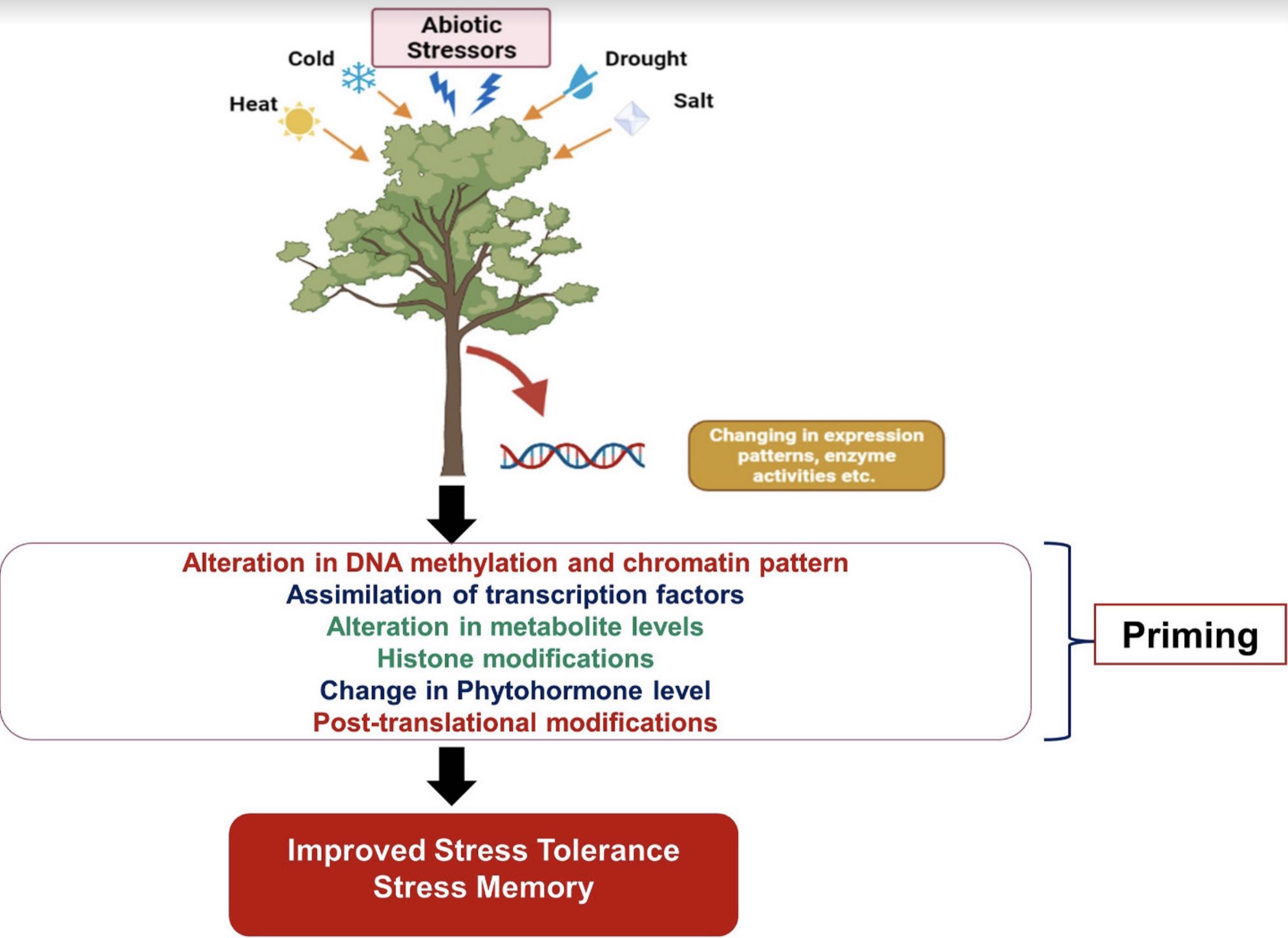The memory and intelligence of plants are due to molecular networks that enable them to remember, choose and make decisions based on environmental stress stimuli.
Thus, plants, although lacking a nervous system, can optimize their available resources.
A recent study (Gallusci et al., 2022) in Trends in Plants Science also shows the ability of plants to pass on their experience to subsequent generations through epigenetics. (1) This is how nature evolves and adapts, without the need for genetic engineering.
Memory, intelligence and learning of plants
To claim that plants have a memory is to recognize in them a form of intelligence. Indeed, without memory it is not possible to learn, and learning is a requirement of intelligence itself.
On the other hand, only a being with ingenuity can be able to improve the efficiency of its reaction after being repeatedly subjected to the same environmental condition. (2)
Plant memory. From J.B. Lamarck to Stephen Mancuso
The first experiments confirming plant memory were conducted at the dawn of the 19th century by renowned biologists Jean-Baptiste Lamarck and René Louiche Desfontaines. To whom Stefano Mancuso-author of the book Plant Revolution (on the cover. See note 3)-dedicated the experiment “Lamarck and Desfontaines.”
– Potted plants were subjected to repeated falls. The nontraumatic vertical jump represented the stimulus,
– after a series of repetitions, it was observed that the plants began to stop closing their leaves at successive falls,
– To understand whether this mechanism derived from a form of learning, the plants were subjected to a different stimulus,
– horizontal shaking of the pots generated a different impulse, to which the plants responded by immediately closing their leaves,
– Thus, it was shown that plants could learn the non-hazardousness of an event from the memory of a past experience. (4)
Relationships between plants, their surroundings and memory
Plants, as sessile species, must constantly adapt to external environmental stresses. By regulating their physiological, metabolic and developmental responses.
Adaptation involves a direct relationship between the ability to perceive the environment, epigenetic remodeling, and the development of memory (or priming) in plants.
The priming or memory of plants
Priming is a process by which a transient environmental stimulus elicits adaptive responses (usually rapid and/or stronger) when exposed to repeated stress. It allows the plant to prepare for a better stress response. Priming involves the assimilation of several key proteins or signaling metabolites, as well as the sustained alteration of various transcription factors. Plant metabolism is thus altered and maintained in response to various stresses.
The sensory systems that determine primary contact with the environment are diverse and use various types of macromolecules. From receptor proteins (photo and thermosensors) to nucleic acids (RNA) and subcellular organelles (chloroplasts and mitos), which sense and transmit environmental (quality, quantity and direction of light and temperature) and biochemical signals. The plant stores a signal and uses it to take advantage of it.

Climate change and plant memory
The depletion of crops due to abiotic stresses (heat, drought, salinity and cold) is the biggest obstacle to their productivity and food security, in the global scenario of climate change and desertification. (6) In recent years, efforts have been made to understand the influence of abiotic stresses on plant development, quality and productivity and how plants react/adapt to such stresses.
The increase in global average temperature has increased the harmful effects on plants due to various abiotic stresses. Which adversely affect the growth and development of plants, forcing them to rapidly adapt their structural organization, photosynthetic process, metabolism and functions (lipid/hormonal signaling, etc.) to resist.
1) Memory of drought stress
Drought is one of the most damaging causes of stress to plants. (7) In fact, it causes a reduction in growth and carbon fixation, negatively affecting plant productivity and survival. Which, in response to drought stress, have evolved various mechanisms such as the regulation of gene expression of various processes (physiological and developmental).
Water scarcity conditions can be memorized by plants, which respond to them differently after the first experience to survive the repetition of the stress. Drought tolerance in plants has been associated with the accumulation of osmoprotective proteins (e.g., dehydrins), soluble sugars, and phytohormones. In addition to the decrease in the photosynthetic system.
2) Heat stress memory
Heat stress (HS, heat stress) is due to the increase in soil and air temperatures beyond the limiting levels that allow each plant to function physiologically and biochemically through the regulation of molecular processes. Plants naturally cope with heat stress with basal heat tolerance.
The acquired thermal tolerance allows plants to withstand higher temperatures after a short pre-exposure(thermopriming). Thermopriming also mediates the increased expression of HS transcription factors that modulate the expression of heat shock proteins (HSPs) and many antioxidant genes to promote recovery.
3) Memory of salinity stress
Salinity is one of the most serious risks to agricultural productivity, as it adversely affects plant development by reducing photosynthetic activity, water uptake efficiency and stomatal closure.
Ionic stress caused by salt absorption beyond the optimal level affects metabolic activity, essential ion homeostasis, and plasma membrane integrity.
Exposure to salinity stress enabled the plants to develop drought resistance as well, with memory protracted for 10 days after the initial moment.
4) Cold stress memory
Cold weather also affects the life cycle of plants by altering seed germination, plant growth and flowering period, resulting in crop losses. Cold exposure (or vernalization) is a direct link between the environment and the creation of somatic epigenetic memory to regulate flowering initiation.
Studies onArabidopsis (common Arabidopsis, Brassicaceae family) demonstrate a distinct temperature sensing mechanism. Vernalization operates through a digital epigenetic switch, leading to silencing of the Flowering Locus C gene. (FLC):
– at the time of birth the FLC gene is active and the plant does not produce flowers,
– during cold winter weather, the FLC gene is ‘switched off’ so that flowering is reserved for favorable weather conditions.
Epigenetics and heredity
The changes that occur in plants in response to stresses are epigenetic in nature. That is, they are patterns of gene expression, which occur without altering the DNA sequence but rather at the chromatin level.
These changes-essential in the memory construction(priming) of plants-therefore transcribe their response to the environment into an epigenetic alphabet.
Epigenetic information can be transmitted during a plant’s life as somatic inheritance, i.e., through vegetative propagation (clonal reproduction) during mitosis, via stem cells located in the meristems.Cultivation
Interim conclusions
The value of plant memory studies goes beyond botanical interest. Memory from abiotic stresses can have a positive impact on plant well-being in terms of resilience in natural ecosystems and the development of new technologies.
Further research is needed to arrive at a comprehensive, mechanistic understanding of the fundamental molecular pathways and evolutionary ecology of these processes. Without neglecting some parallels with neuroscience. (8)
Giulia Pietrollini
Notes
(1) Gallusci P., Agius D. R., Moschou P. N., Dobránszki J., Kaiserli E., Martinelli F. (2022). Deep inside the epigenetic memories of stressed plants. Trends in Plant Science. https://doi.org/10.1016/j.tplants.2022.09.004
(2) De Lamarck, J.B. (1815). Flore française ou descriptions succinctes de toutes les plantes qui croissent naturellement en France disposées selon une nouvelle méthode d’analyse; et précédées par un exposé des principes élémentaires de la botanique Desray
(3) Stefano Mancuso. Plant revolution: plants have already invented our future. Giunti ed., Milan, 2017. ISBN 9788809831360
(4) Gagliano M., Renton M., Depczynski M., Mancuso S. (2014) Experience teaches plants to learn faster and forget slower in environments where it matters. Oecologia, 175(1), 63-72. doi: 10.1007/s00442-013-2873-7
(5) Rajasekhar VK, Vemuri MC. Molecular insights into the function, fate, and prospects of stem cells. (2005). Stem Cells, 2005 Sep;23(8):1212-20. doi: 10.1634/stemcells.2005-0336
(6) Dario Dongo, Giulia Torre. Desertification and soil degradation, PRIMA’s research and innovation. GIFT (Great Italian Food Trade). 22.6.22
(7) Dario Dongo. Drought, agricultural water, and pond scofflaws. #CleanSpades. GIFT (Great Italian Food Trade). 15.8.22
(8) Pedro Royero, Anne Quatraccioni, Rieke Früngel, Mariella Hurtado Silva, Arco Bast, Thomas Ulas, Marc Beyer, Thoralf Opitz, Joachim L. Schultze, Mark E. Graham, Marcel Oberlaender, Albert Becker, Susanne Schoch, Heinz Beck (2022). Circuit-selective cell-autonomous regulation of inhibition in pyramidal neurons by Ste20-like kinase. Cell Reports, Vol 41, Issue 10, Dec. 6 2022. doi:https://doi.org/10.1016/j.celrep.2022.111757
Graduated in industrial biotechnology and passionate about sustainable development.








